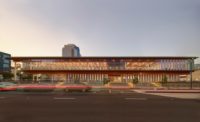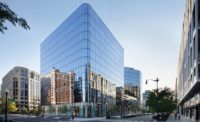Geneva
Adding on to a successful work of architecture is hard enough. It can be even harder if you designed the original project yourself. How do you make a new, distinctive statement that doesn’t overwhelm the first? Bernard Tschumi, who keeps offices in New York and Paris, faced this problem with his recent commission to provide a 110,000-square-foot addition to his Vacheron Constantin Headquarters and Watch Factory in Geneva (RECORD, June 2005).
The architect’s original curved stainless-steel building, completed about 10 years ago, rises elegantly above the industrial park at Plan-les-Ouates on the outskirts of the city—a talisman of the 260-year-old business so effective that the management once again turned to Tschumi when it came time to expand. The company’s CEO, Juan-Carlos Torres, just said to the architect, “I’m in love with the original building—don’t compete with it.” Since Geneva is the home to such Vacheron rivals as Rolex, Patek Philippe, and Piaget, Torres wanted to make sure the architecture retained its singular image.
For his earlier commission, Tschumi designed a 130,000-square-foot, four-story building with executive offices for 90 and an attached factory for 80. This time, he needed to provide offices and workshops for 375 employees, along with dining facilities for both buildings and additional parking.
With the new building, the architect responds to his first scheme by gracefully riffing on its vocabulary of materials and form—such as the perforated stainless-steel cladding that curves around the headquarters—without replicating or dominating the original.
Yet the footprint of Vacheron 2 varies dramatically from its predecessor: it takes on the form of an irregular V in plan, determined partially by the external roadways that bound the seven-acre site. At one point toward the rear, where the two buildings almost touch, Tschumi connects them with a glazed link.
While the V shape creates a number of acute angles, Tschumi conceals the sharpness along the front of the complex—where the two arms of the new structure jut forth—by wrapping those wings, on the second level, with bull-nosed, perforated stainless-steel hoods. This formal gesture, echoing the contours of the original Vacheron, effectively unites the old and the new for those entering the gate to the complex.
On a lawn between the older structure and its addition, Tschumi has placed an elongated glazed shed covering a stepped entrance ramp that angles down to the poured-concrete underground level. Here, the watchmakers arrive each day and change into lab coats and special shoes next to parking for workers’ cars and bikes.
Trucks delivering materials and picking up goods stop at an open court in the notch between the two arms of the V. One arm even allows trucks to roll inside for protected unpacking and loading. While fewer than 30,000 watches a year are made by Vacheron, they range in price from $13,000 to $242,000, which requires a vigilance against theft. A security firm reviewed Tschumi’s plans; following the firm’s recommendations, the team placed freestanding poured-in-place-concrete walls just inside the truck loading bay—barely visible behind the glass window walls—to protect against the possibility of rogue trucks’ ramming through the building. Offices occupy the other arm at ground level, while at the back of the V—where both wings are joined—the cafeteria and dining rooms open out to a lawn.
At the core of the building, at the juncture of the two arms, Tschumi has carved out an atrium with a cranked stairwell topped by a large skylight. This lobby space not only provides added top light but helps unite the two levels with the one below ground. Tschumi found this formal strategy helped resolve the meeting of its two arms, while acting as an orientation point for those unfamiliar with the plan. The interior effect does not have the gracefulness of the exterior swerves: there is a certain dissonance in the way the angular stairs lurch up to the circular oculus, even with the finely crafted detailing of the steel framing for the translucent glass treads and clear glass balustrades.
The upper level offers dramatic views of the Alps for the watchmakers, who work at chin-high desks in air-locked dust-free and humidity-
controlled studios. To provide employees with the soft, even illumination required for their painstaking tasks, the architects inserted circular skylights alternating with smaller circular ceiling fixtures that float above the work stations. Glazed interior walls also help transmit light.
Because of the expansive use of glass, Tschumi installed a movable louvered blind system. In the older structure, he placed the adjustable blinds between an outer panel of glass and interior double-layered glass, which meant the outer panel had to be removed for cleaning the glass inside. In the new building, the architect installed black aluminum blinds outside, which still cut solar gain while nicely articulating the exterior surfaces.
Other stalwart features of sustainable buildings, such as operable windows and natural ventilation, are missing, in large part because the workshops must adhere to strict temperature and humidity requirements. But the design team did install 15,000 square feet of solar panels on the roof, which provides about 10 percent of the building’s energy needs.
Seeing the watchmakers carefully assemble their ornate timepieces—one workshop is named Studio des Grandes Complications—in these calm, clean aeries, you note that the abstract, sleek, and precisely detailed architecture echoes the qualities of the watches created within. Tschumi has reinvented his own vocabulary of curved, glinting metallic forms that encase a concrete structure. While relying on the architectural DNA of the first building, Tschumi’s second take gives it a different twist. It brings something familiar but entirely new to the Vacheron campus.
PeopleArchitect:
Bernard Tschumi Architects Personnel in architect's firm who should receive special credit:
Bernard Tschumi Architects: Bernard Tschumi, Paul-Arthur Heller, Clinton Peterson, Nicolas Grillet, Pierre-Yves Kuhn, Joel Rutten Associate architect: Glauco Lombardi Engineers:
MDI Ingénieurs civils (Structure) Consultants
BCS (Façade) Photographer: Peter Mauss, 212 721 6264
|
ProductsStructural System
Basement and ground floor: concrete frame Precast concrete columns: Rampini Exterior Cladding Masonry: Rampini Metal panels: Hevron Metal/glass curtain wall: Hevron Rainscreen: Hevron Wood: Floors: HKM Curtain wall: Hevron Roofing Built-up roofing: Hevron Metal: Hevron Windows Metal frame: Hevron Glazing Glass: Hevron Skylights: Hevron Doors Metal doors: Hevron Hardware Locksets: Arteferro Closers: Arteferro Interior Finishes Acoustical ceilings: Trisax; MWH Demountable partitions: Trisax Cabinetwork and custom woodwork: Expodesign Paints and stains: Léman Group Floor and wall tile: Gatto Lighting Interior ambient lighting: Badel Downlights: Badel Tasklighting: Badel Energy Energy management or building automation system: Tech-Building Other Components
Elevators: AS Ascenseurs |















